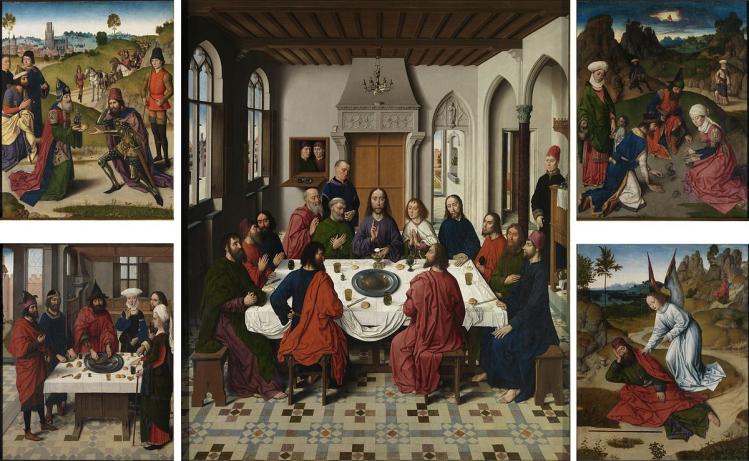
The Light of Christ
An Introduction to Catholicism
Thomas Joseph White, OP
Catholic University of America Press, $19.95, 328 pp.
Introductions assume the veil of ignorance. When, at a party, I bring an old friend over to you so that I can introduce you, it’s because I think you haven’t met before and would like you to. If, in a bookstore, I leaf through an introduction to Catholicism (or dressage, or lichens), it’s typically because I don’t know much about these things, and would like to. Introductions give you something or someone new to think about, talk about, and spend time with. When they work well, they’re also a vade mecum, a guide you can keep with you to consult as needed, and so deepen and strengthen your new acquaintance.
Usually introductions vouch for what they introduce. The one who makes the introduction ordinarily loves, or at least likes, what she’s introducing: she’s taken the trouble to get to know it, and she’d like you to do the same. Perhaps she thinks that what she’s introducing is good for you to know: it seems to her that it’s medicine everyone needs, and so she’s an evangelist for it. But sometimes the one who makes an introduction does not like what she’s introducing. Ordinary cocktail-party courtesy might require me to introduce my enemy to you, even if I think he might be bad for you to know. Perhaps I’ve spent my life studying something I dislike (totalitarianism, violence, chicory), and I write an introduction to it. Such an introduction may be a warning as well as an offer: here’s what you need to know about this so that you can avoid being damaged by it.
You might think there are introductions that neither vouch nor warn but only lift the veil to show what’s there. That would be a mistake. When I introduce you to someone, the introduction inevitably does more than show her to you; it shows her to you as my friend—or acquaintance, or enemy, or colleague, or spouse—and in that way shapes her for your acquaintance. So too, more obviously, in the case of writing an introductory text, whether to calculus or Catholicism. Choices are made that shape the phenomenon. Gibbon’s depiction of the Arian controversy is in almost every way different from Newman’s, even though each might reasonably be understood as an introduction to that wrinkle in Christianity’s history.
Thomas Joseph White’s The Light of Christ: An Introduction to Catholicism is the work of a lover. It vouches for and advocates what it introduces, and is eager for you to embrace it. White is sure that you need to love what he shows you, and the spirit of a lover breathes through his introduction, even if it’s the spirit of a Dominican lover whose loves are, originally and finally, intellectual. What he shows you is a pattern of thought—a way of understanding the cosmos as a whole and in all its particulars. He shows you what the church teaches, and shows it as the truth. He’d like you, the reader, to apprehend it and make it your own.
How does he do it? By following the example of St. Thomas Aquinas, which is, I suppose, a natural and proper thing for a Dominican to do. Thomas’s Summa theologiae is an introduction to Catholic Christian discourse about God and the world, intended, Thomas writes, for the formation of beginners (incipientes, those making a start: he had in mind Dominican novices) in that way of thinking so that they might then be able to communicate it to others, especially in preaching. The Summa begins with a treatment of God, and creation as the going-forth of things from God. Then it depicts the movement of human creatures back to God by way of their acts—this is the bulk of the Summa, and it’s approximately what we would call moral theology. The work then shows Jesus as our way back to God, and the sacramental economy of the church as the particular means instituted by Jesus for that purpose. And it concludes, or would have concluded had Thomas completed it, with an analysis of the last things, in which the heavens and the earth are rolled up like a scroll and all things assume their final and fixed relation to God.
The Summa’s schema is one of exitus-reditus: it shows how all things come from God by way of creation out of nothing, and then return to God by way of salvation or damnation. It also shows, in outline, what happens between the beginning and the end, and what kinds of things there are in the world and how they relate one to another. The Summa works remorselessly at the level of the concept. Its central devices are the definition and the distinction, and what it establishes by way of these is the grammar of the faith. It introduces the reader to the lexicon and syntax of church teaching, together with that of some speculative questions on which the church has not yet come to any doctrinal conclusions.
White does the same thing in Light of Christ, though in a very different style. After some preliminaries on faith, revelation, and reason, he sets out the central claims of the Christian faith on the following subjects in the following order: God; creation and the human person; incarnation and atonement; the church; the church’s social doctrine; and the last things. The schema is essentially the same as Thomas’s, and the goal is the same, too. Anyone who reads White’s book attentively will learn a grammar, and will take at least the first steps in being able to use it—to think and speak and write as Christians do. White’s book is neither as long nor as technical as Thomas’s, but they’re alike in all these respects. They’re alike, too, in lucidity: White writes with consistent and careful transparency, and without either the folksy simplifications of popular theology, or (mostly) the rebarbative technicalities of in-house Thomism. This isn’t easy to do, as anyone who’s tried it will know. If you want a reliable guide to the scope and shape of Christian claims, you’ll find it difficult to do better than this.
But there is a problem of internal coherence in White’s book, and it’s one that the Summa doesn’t suffer from. What White introduces isn’t exactly what he says he’s introducing. He says he’s introducing Catholicism, which, as he puts it in a nicely turned couple of sentences at the end of the book, is a form of life: “The grace of Christ crucified is the source of the Church’s life, her devotion to the truth and her freedom to love. Therein lies the essence of Catholicism: at the heart of the Church is the life of Christ.” On this understanding, the church has, or is, a life, and that life is Christ. To be introduced to the church is to be introduced to, and asked to share in, a form of life—a mode of being in the world. This seems reasonable and accurate. Catholicism is a life to be lived in response to a prevenient gift. The essence of that life (White doesn’t say so, but I think he’d agree) is liturgical. It’s a complex and beautiful series of offerings-back to God of what God has given in Jesus. This life, the life of Christ into which Catholics enter when they come to participate in the life of the church, has as its goal the liturgization of human life in all its aspects—social, political, artistic, familial, sexual, sartorial, gastronomic, and so on. Catholicism is a form of life that embraces and transfigures all others, absorbing them into itself by inscribing them into its margins. It is the way in which we humans most fully participate in the life of Christ, who himself embraces and transfigures all things.
If that’s what Catholicism is (and it is), how does one introduce it to those who don’t know it? Not by doing what White does in this book. A form of life isn’t the kind of thing that can be introduced by elucidating its grammar. Thomas, I think, knew this. The Summa, introductory though it is, had a more specific purpose than White’s book, a purpose for which grammatical training is essential. Thomas wanted to provide Dominicans with a form of understanding appropriate to their vocation of teaching and preaching. You need grammar for that. The novices for whom Thomas writes are already living the church’s life, and what they need is to know how to talk about it. White’s audience, by contrast, needs to have the veil lifted from the church’s distinctive form of life.
If I want to show my friend to you so that you can see what a good friend she is and want to get to know her as only a friend can, I won’t be able to do that by explaining her to you. I can, of course, do that. I can elucidate her good qualities, explain what she does in the world, and so on. If I do any or all of that, I’ll be doing for friendship what White does for the church; I’ll be giving you a grammar of friendship, explicating what it is to be a friend and how it is that those who understand friendship talk about it. But that’s not how to get you to become my friend’s friend. For that, I need to show you her face, get you to spend some time with her, and hope that in doing these things you’ll want to deepen your acquaintance.
Training in grammar is not aimed at drawing people into a form of life; neither, generally, has it the power to draw them. The difference between explaining the principles that give shape to a form of life and living that form of life is easy enough to see if you keep in mind that skilled practitioners typically don’t need to understand—much less be able to explain—what they do in order to do it well. On the contrary, being a good explainer often hinders being a skilled practitioner. The eye-hand coordination of a good baseball player doesn’t require the capacity to give an account of fast-twitch muscle reflex. Similarly, participating in the life of Christ, which is at the heart of the church, doesn’t require the ability to give an account of the theological principles that order such a life.
White’s mistake here is characteristic of Thomists—though not, I think, of Thomas. It is to overestimate the significance of cognitive-intellectual skills in human life, both here below and in heaven. This is evident in White’s first chapter, where he acknowledges, of course, that humans aren’t merely creatures who understand, but also creatures who desire, and that our proper development requires the shaping of both understanding and desire. But the two are hierarchically ordered for him: “The intellect is what is most noble in the human being,” he writes, and, “the highest, most vivifying thing we can do is contemplate the truth” (here he’s summarizing but also endorsing Aristotle). Genuine love, White claims, requires knowledge (understanding) of what’s loved. And we humans are, essentially, those who want to know. Heavenly life is contemplative, and what we contemplate is the truth. And so on.
But this sort of thing conflates what should be kept separate. On the one hand there’s know-how: knowing what to do next; how to live well; when to use this word and when to use that; how taut the bowline needs to be just now, with the wind as it is; what to do when faced with the flesh of Christ. On the other there’s knowing-that: the rarefied and technical capacity to give an account of what it is that one is doing, or might do, or should do. If “intellect” in the claim “the intellect is what’s most noble in the human being” means what’s deployed in know-how, then the claim is true. But if it means what’s deployed in knowing-that, then it’s false. Even if, as I expect, White would not agree with me, to note the difference between know-how and knowing-that would have been an appropriate corrective to his tendency to over-intellectualize. The church honors the martyrs over the theologians, as is right. That’s because they know what to do, whether or not they know what account to give of what they do. Theologians, on the other hand, might be very good at offering such an account, while yet being incapable of worship, much less martyrdom.
Theologizing, explaining the faith’s grammar, is an enterprise for the few here below, and will be of no use at all in the end. White is good at it, and does it well in this book. But he mistakes its significance, and so what he introduces isn’t Catholicism, but rather the grammar of well-formed talk about it. He appears to show some (uneasy?) awareness of this lack by including a short epilogue on prayer at the end of his book. This is as close as he gets to unveiling what life as a Catholic is like; and even here, his focus is grammatical-conceptual rather than descriptive-analytical.
How to do better? Hagiography (the writing of holiness) is the first answer. The life of Christ at the church’s heart is most fully evident in the shape of those lives lived in greatest intimacy with Christ. And that shape can best be shown by literary genres very different from the one White chooses for his introduction. When I introduce Catholic Christianity to undergraduates, I generally use biographies, autobiographies, poetry, and fiction as my main sources. Slow and serious time spent with Gerard Manley Hopkins’s “Wreck of the Deutschland,” or Athanasius’s Life of Antony, or Bonaventure’s Life of Francis, or Flannery O’Connor’s Wise Blood, or Georges Bernanos’s Monsieur Ouine, unveils the Catholic faith more fully and more lovingly than any amount of grammatical explication can.
A second answer is attention to the liturgy, which is to say to what Catholics do when they’re doing what’s most characteristic of the Catholic form of life. A close description of, for instance, the rite of baptism, using both the text of the rite and analysis of how that text may be performed, shows how it is that someone is incorporated into Christ, made a member of that body. What’s said and done by priest, godparents, parents, baptizand, and congregation introduces, with a thickness and texture unavailable otherwise, how Christians are made and what, therefore, they are. The rite is beautiful; even an analysis of it stands a better chance of drawing someone to the faith than doctrinal catechesis does.
There are, it is true, some who are moved by grammar, though perhaps fewer than White thinks. But however many there are, White’s book is for them, and it’s a first-rate example of its kind. It’s also, like its model, the Summa, a very good manual for those who need grammatical training. If that’s you, you should read it.
Samuel Johnson, with acute self-deprecation, called lexicographers harmless drudges. They do work that needs to be done, but it isn’t work that most language-users need to know anything about; lexicographers and grammarians who overestimate and misunderstand the importance of the work they do easily come to think of themselves as legislators and guardians of language, or even as those whose work must be understood before words can be responsibly uttered. That’s an absurd view, and there’s something of it, mutatis mutandis, in White’s book and in the work of other Thomists. Modesty is more becoming. An introduction such as the one under review here is the work of an under-laborer in the service of the church, and it would be a better book if it had presented itself as such. The most puzzling (to me) feature of the book is its uncritical overestimate of the importance of theology in the church’s life, and, concomitantly, of the importance of the intellect—of knowing-that—in human life. I, like White, am a professional theologian; I, like him, am a Catholic. But I don’t recognize in his understanding of these matters what I do or who I am.
Please email comments to [email protected] and join the conversation on our Facebook page.
Previous Story
Using the Courts to Destroy Unions
Next Story
Making Wakanda Great Again


